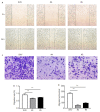[SOX2-OT/SOX2 axis regulates lung cancer H520 cell migration via Gli1-mediated epithelial-mesenchymal transition]
- PMID: 36329576
- PMCID: PMC9637495
- DOI: 10.12122/j.issn.1673-4254.2022.10.01
[SOX2-OT/SOX2 axis regulates lung cancer H520 cell migration via Gli1-mediated epithelial-mesenchymal transition]
Abstract
Objective: To explore the regulatory role of SOX2-OT in migration of lung squamous cell carcinoma H520 cells and the underlying mechanisms.
Methods: Wound- healing and Transwell migration assays were performed to examine the changes in migration and invasion capacity of lung squamous cell line H520, which expressed higher levels of SOX2-OT than other lung cancer cell lines, following RNA interference-mediated SOX2-OT knockdown. The transcription levels of epithelial-mesenchymal transition (EMT)-related components was detected by qRT-PCR and immunoblotting. Gli1 gain-of-function analysis was performed in H520 cells with SOX2-OT knockdown and the changes in EMT phenotype of the cells were examined. miR-200c mimic and inhibitor were used to analyze the mechanism by which SOX2-OT positively regulates Gli1 and the mediating role of SOX2.
Results: SOX2-OT knockdown significantly lowered the invasiveness and migration capacity of H520 cells and caused changes in EMT phenotype of the cells. Overexpression of Gli1, which was positively regulated by SOX2-OT, reversed the inhibitory effect of SOX2-OT knockdown on migration of H520 cells. Transfection of the cells with miR-200c inhibitor effectively reversed SOX2-OT knockdown-induced down-regulation of SOX2.
Conclusion: The SOX2-OT/SOX2 axis positively regulates migration of lung squamous H520 cells via Gli1-mediated EMT.
Keywords: Gli1; SOX2; SOX2-OT; epithelial-mesenchymal transition; lung squamous cell carcinoma.
Figures






References
-
- Zhang J, Xu J, Jin S, et al. The development and validation of a nomogram for predicting brain metastases in lung squamous cell carcinoma patients: an analysis of the Surveillance, Epidemiology, and End Results (SEER) database. J Thorac Dis. 2021;13(1):270–81. doi: 10.21037/jtd-20-3494. - DOI - PMC - PubMed
Publication types
MeSH terms
Substances
LinkOut - more resources
Full Text Sources
Medical
